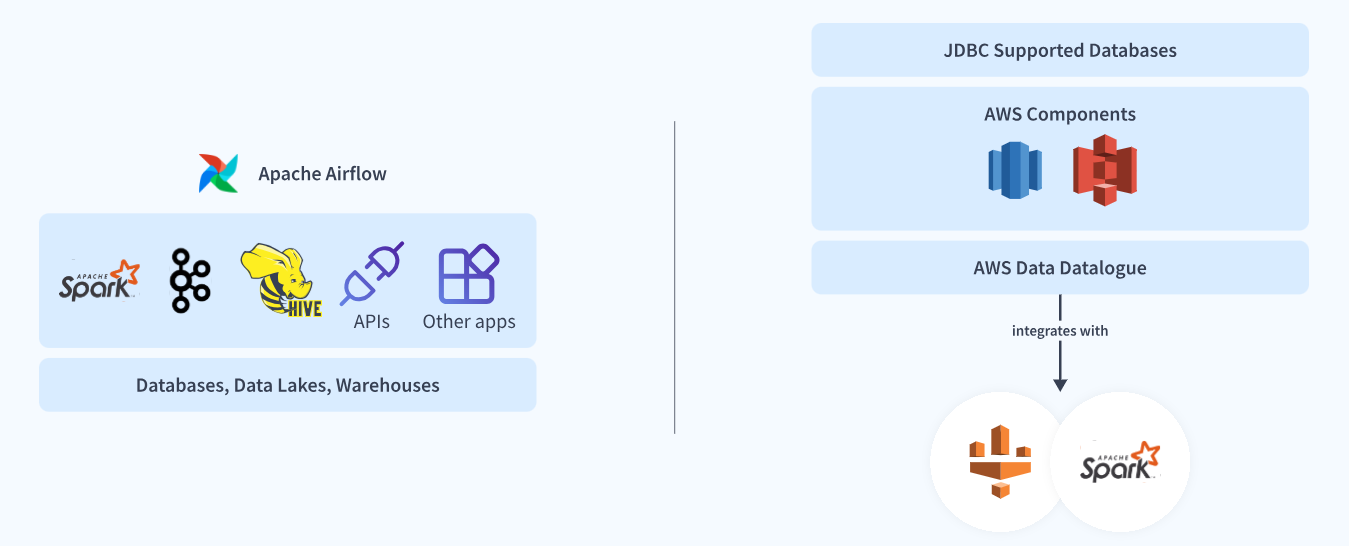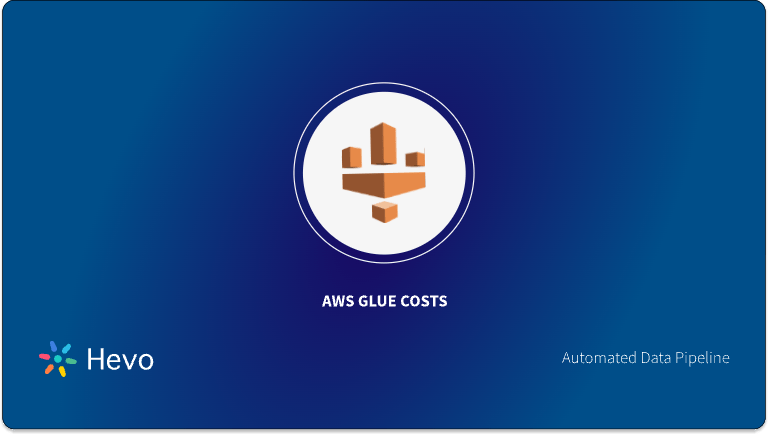In today’s data-driven world, efficient integration and workflow management spell business success. The right tool for orchestrating and automating your data pipelines makes all the difference between operational efficiency and cost-effectiveness. Apache Airflow and AWS Glue are solutions at the top of this sector, each providing specific characteristics and capabilities. Airflow vs AWS Glue will help you know all their powers and weaknesses to pick the best tool for data integration in 2025.
Table of Contents
What is Apache Airflow?
G2 Rating: 4.3(86)
Capterra Rating: 4.6(10)
Apache Airflow, developed by Airbnb, is an open-source platform for managing complex workflows and data pipelines. It allows users to define workflows as Directed Acyclic Graphs (DAGs), providing a clear and structured approach to scheduling and managing tasks.
Key Features of Apache Airflow
- Directed Acyclic Graphs: Airflow uses DAGs to define workflows that organize tasks into a directed graph with dependencies. It is very easy to handle complex workflows in this kind of visualization.
- Task Scheduling and Management: Airflow has strong scheduling capabilities, which lets one specify the exact execution time for a task and handle retries in case of failure. It also supports dynamic task generation.
- Extensibility and Plugins: Airflow’s architecture features a huge set of different plugins and operators, which enable it to integrate with various external systems and databases. This will make the extensibility of functionality possible through custom extensions.
Use Cases of Apache Airflow
- Orchestrating Complex ETL Workflows: Airflow excels at managing multi-step ETL processes which helps in managing dependencies between tasks.
- Data Pipeline Management: It is ideal for handling data pipelines that involve multiple systems and require complex scheduling.
- Custom Integrations: Airflow’s extensibility makes it suitable for scenarios where custom integrations and operations are needed.
What is AWS Glue?

G2 Rating: 4.2(189)
Capterra Rating: 4.1(10)
AWS Glue is a fully managed ETL (Extract, Transform, Load) service provided by Amazon Web Services. It simplifies data preparation and transformation and offers a serverless environment that handles infrastructure management automatically.
Key Features of AWS Glue
- Serverless Architecture: AWS Glue runs a serverless model, so users do not have to worry about the underlying infrastructure. It automatically scales up to handle the workload and uses resources efficiently.
- ETL Capabilities: AWS Glue has tools for extracting data from various sources, transforming it based on business logic, and loading it into target systems. It supports a large number of data formats and sources.
- Data Catalog and Crawlers: AWS Glue offers a data catalog that automatically captures metadata, organizes it, and makes it easier to manage. Crawlers enable data to be automatically discovered and cataloged so that users can more easily query and organize huge datasets.
Use Cases of AWS Glue
- Automating Data Preparation: AWS Glue is well-suited for automating ETL processes and data preparation tasks, especially in scenarios requiring minimal manual intervention.
- Integration with AWS Ecosystem: It integrates seamlessly with other AWS services, making it ideal for users heavily invested in the AWS ecosystem.
- Handling Large-Scale Data Transformations: Its serverless nature allows it to efficiently handle large-scale data transformations and migrations.
Airflow vs AWS Glue: Feature Comparison
| Feature | Airflow | AWS Glue |
| Architecture | Airflow provides a modular architecture with flexibility in deployment, including on-premise and cloud options. | AWS Glue operates on a serverless architecture, automatically managing resources and scaling based on workload. |
| Ease of Use | Airflow offers a rich interface with extensive configuration options, which can have a steeper learning curve. | AWS Glue simplifies the ETL process with a user-friendly setup designed for ease of use and minimal configuration. |
| Integration | Airflow supports various integrations through its operators and plugins, accommodating diverse systems and databases. | AWS Glue integrates well with AWS services and supports various data sources, making it a strong choice for AWS-centric environments. |
| Transformations | It does not directly handle transformations but facilitates the orchestration of tasks that include transformations. Users can write custom scripts. | Includes a range of built-in transformation functions and libraries. |
| Scalability | Airflow scalability involves adding more worker nodes and managing the cluster, which requires manual intervention. | AWS Glue scales automatically based on the workload, providing a seamless experience without manual scaling. |
| Cost | It is free, but you have to manage your infrastructure costs. | AWS Glue’s pricing is based on the resources consumed and the duration of ETL jobs, offering more predictable and often lower costs for serverless operations. |
| Learning Curve | Airflow’s extensive features and configurations can present a steep learning curve for new users. | AWS Glue’s managed environment and serverless model can be easier to learn and use effectively, with less emphasis on infrastructure management. |
| Vendor Lock-IN | No | Yes |
| Python Support | Yes | Yes |
Hevo stands out in the crowded data integration space with its unique features, user-friendly platform, and transparent pricing.
Unlike Airflow and Glue, Hevo offers:
- No-Code Platform: Hevo’s intuitive, no-code interface allows users to set up and manage data pipelines without needing extensive technical expertise.
- Quick Deployment: Hevo’s streamlined setup process means you can deploy data integration solutions faster, reducing time to value and allowing your team to focus on strategic tasks.
- Custom Transformations: Customize your data workflows with Hevo’s powerful transformation capabilities.
Join over 2000 happy customers who trust Hevo for their data integration needs and experience why we are rated 4.7 on Capterra.
Get Started with Hevo for FreeDetailed Comparison of Airflow and AWS Glue
Architecture

Apache Airflow is designed with a modular architecture that consists of several key components:
- Scheduler: The Scheduler is responsible for scheduling and executing tasks. It determines when and how tasks should run based on defined DAGs (Directed Acyclic Graphs).
- Executor: An Executor executes the tasks defined in the DAGs. Airflow supports multiple executors such as LocalExecutor, CeleryExecutor, and KubernetesExecutor, allowing flexibility in deployment based on scale and needs.
- Web Server: Provides a web-based interface for monitoring and managing workflows. Users can view DAGs, task statuses, and logs.
- Metadata Database: This database stores information about DAGs, tasks, and execution states. Airflow uses relational databases (e.g., PostgreSQL, MySQL) for metadata storage.
AWS Glue operates on a serverless model, which means:
- Serverless Environment: Users do not need to manage the underlying infrastructure. AWS Glue automatically provisions and scales resources based on the workload.
- Data Catalog: AWS Glue includes a Data Catalog that automatically manages metadata and makes it accessible for ETL processes. It simplifies data discovery and integration.
- ETL Jobs: Glue jobs run on a managed environment with automatic scaling. Users define jobs using Glue’s built-in transformations or custom scripts in Python or Scala.
Ease of Use
- Airflow
- Setup Complexity: Setting up Airflow involves configuring multiple components (scheduler, executor, web server) and connecting to a metadata database. This setup can be intricate and may require substantial configuration and maintenance.
- Customizability: While Airflow offers high flexibility and customization, this can increase the complexity of the setup and use, especially for users unfamiliar with its architecture.
- AWS Glue
- Simplified Setup: Glue’s setup is generally easier, particularly for users familiar with AWS. It offers built-in features and wizards that streamline the creation and management of ETL jobs.
- Visual Tools: Glue Studio offers a drag-and-drop interface for creating ETL jobs, making it more accessible for users without extensive technical backgrounds.
Scalability
- Airflow
- Manual Scaling: Scaling Airflow involves managing executors and worker nodes. For example, CeleryExecutor or KubernetesExecutor allows horizontal scaling but requires careful configuration and management.
- AWS Glue
- Automatic Scaling: AWS Glue’s automatic scaling automatically adjusts resources based on the volume and complexity of ETL jobs, eliminating the need for manual scaling.
Cost
- Airflow
- Variable Costs: The cost of Airflow depends on the deployment method. Managed Airflow services may have associated costs, while on-premises deployments involve infrastructure and maintenance expenses.
- Infrastructure and Maintenance: On-premises deployments can be cost-effective but require investment in hardware, maintenance, and operational resources.
- Cloud-Based Pricing: For cloud-based or managed services, pricing may include charges for compute resources, storage, and additional services, which can vary based on usage and configuration.
- AWS Glue
- Pay-As-You-Go: AWS Glue follows a pay-as-you-go pricing model, with costs based on Data Processing Unit (DPU) hours, data catalog storage, and data crawlers.
- Free Tier: AWS Glue offers a free tier with limited resources, useful for evaluating the service or small-scale projects without immediate costs.
- Serverless Savings: The serverless nature of Glue can lead to cost savings by reducing the need for manual infrastructure management and optimizing resource usage based on workload.
Limitations
Every tool has limitations, which can affect its suitability depending on the use case. Understanding these limitations is crucial for Apache Airflow and AWS Glue to deploy and manage effectively. Below, we outline the specific limitations of each tool to help guide your decision-making process.
Limitations of Airflow
- Setup Complexity: Airflow requires detailed configuration and management of various components like the scheduler, executor, and metadata database. This can be challenging, especially for users new to Airflow or those deploying it on-premises.
- Maintenance Overhead: Managing an Airflow deployment involves ongoing maintenance tasks, including updates, performance tuning, and troubleshooting, which can be resource-intensive.
- Steep Learning Curve: The web interface and DAG-based workflow management can be complex for new users. Understanding task dependencies, creating custom operators, and navigating the interface may require substantial time and effort.
Limitations of AWS Glue
- Pre-Built Transformations: While AWS Glue provides built-in ETL transformations, customization options may be limited compared to more flexible tools. Users with specific or complex transformation needs may find the built-in options insufficient.
- Custom Code Integration: Although Glue supports custom code in Python or Scala, integrating custom transformations may not be as straightforward as with tools that offer more flexible programming environments.
- Variable Costs: While AWS Glue offers a pay-as-you-go pricing model, costs can escalate with high data volumes and frequent ETL jobs. Users need to monitor usage and optimize job configurations to manage costs effectively.
To further explore data integration tools, check out our comparison of Talend vs Airflow to find the right fit for your needs.
Why is Hevo a better choice than Airflow and Glue?
Hevo is a no-code data integration platform that simplifies connecting and syncing data across multiple sources in real time. It offers an intuitive interface, automatic scaling, and robust performance, making it an efficient and cost-effective solution for modern data workflows.
- More straightforward Setup and Management:
- Airflow’s complex configuration and maintenance requirements can be challenging for beginners. Hevo’s no-code, user-friendly interface simplifies setup and management, reducing the learning curve and operational overhead.
- While AWS Glue is easier to set up than Airflow, it still involves managing and configuring ETL jobs and data catalogs. Hevo offers a more streamlined approach with fewer manual configurations.
- Real-Time Data Processing:
- Airflow can face performance and latency issues with large or complex workflows, requiring manual performance tuning. Hevo provides real-time data processing with low latency, ensuring up-to-date data availability.
- AWS Glue’s serverless model handles scaling automatically but may not always meet the real-time processing needs of certain applications. Hevo’s real-time capabilities offer a more immediate data integration solution.
- Reduced Infrastructure and Cost Management:
- On-premises or self-managed Airflow deployments require significant infrastructure management and can incur higher operational costs. Hevo’s managed service model minimizes infrastructure concerns and offers transparent pricing.
- AWS Glue’s costs can accumulate with frequent ETL jobs and large data volumes. Hevo’s cost-effective pricing model, with clear cost structures and efficient resource utilization, can offer better cost management.
Conclusion
When choosing a data integration tool, it’s crucial to consider your specific needs, technical expertise, and long-term goals. Apache Airflow and AWS Glue are powerful tools with distinct advantages, but they also come with limitations that may pose challenges, particularly in terms of complexity, performance, and cost management.
If you’re exploring alternatives to AWS Glue, Hevo’s intuitive interface and real-time data capabilities stand out. Discover how Hevo and other AWS Glue alternatives compare in our detailed guide.
Hevo offers a compelling alternative by addressing many of these challenges head-on. With its user-friendly interface, real-time data processing, automatic scaling, and transparent pricing, Hevo simplifies data integration while providing the flexibility and performance needed for modern data workflows. For organizations looking to streamline their data integration without getting bogged down by the intricacies of Airflow or the ecosystem dependencies of AWS Glue, Hevo presents a robust, cost-effective solution that can grow with your business.
FAQ Airflow vs AWS Glue
1. Why not use AWS Glue?
Limited Customization: Pre-built transformations may not meet all specific needs.
Cost Management: Costs can escalate with high usage.
AWS Dependency: Tightly integrated with AWS, which may limit multi-cloud or hybrid deployments.
2. What is better than AWS Glue?
Hevo: Simplifies data integration with a no-code interface, real-time processing, and transparent pricing.
3. What is the difference between AWS Glue and Airflow?
AWS Glue: Serverless, managed ETL service with automatic scaling, designed for ease of use within the AWS ecosystem.
Airflow: Open-source workflow orchestration tool offering flexibility but requiring manual setup and maintenance.











